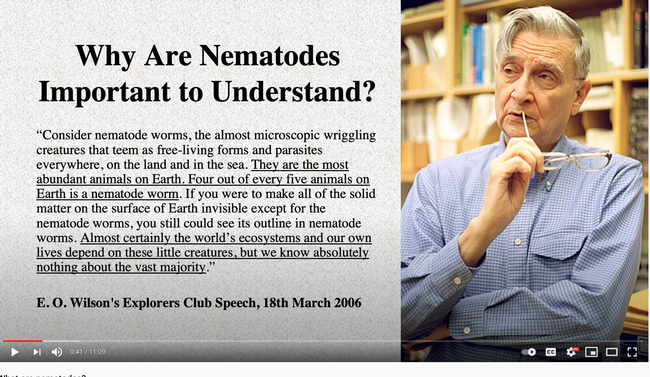
That's a question that nematologists are frequently asked.
Well, just in time for the UC Davis Biodiversity Museum Month (that would be our month of February!), nematologist Steve Nadler, professor and chair of the UC Davis Department of Entomology and Nematology, answers that very question in his 11-minute YouTube video, https://youtu.be/3fhv-P_O8I8. .
Nematodes are known as "round worms" and most are microscopic, he says in his family friendly, easy-to-understand video.
"The famous naturalist E. O. Wilson who studies ants notes that 80 of the individual animals living on the earth are nematodes," Nadler says. "They are clearly important to the earth's ecosystems, even if we don't fully understand all the things that they do, and as parasites they affect human health, the health of other animals, and reduce our food production so they're clearly important in that respect."
You'll want to watch the rest of it.
Nematodes are just one of the topics of videos posted on the UC Davis Biodiversity Museum Month website. Others affiliated with the UC Davis Department of Entomology and Nematology focus on butterflies, moths, arachnids, millipedes, and how to collect, preserve and identify insects.
Other videos posted on this site for free, public viewing include:
- "Virtual Tour of the Bohart's Lepidoptera Collection," a 13-minute Aggie Video by Diane Ullman, professor and former chair of the UC Davis Department of Entomology and Nematology. She describes the natural history and ecology of several colorful and toxic species in the Bohart Museum of Entomology. See https://bit.ly/2LHYFzL
- "Insect Collection, Preservation and Identification," a 15-minute Aggie Video by Steve Heydon, senior museum scientist, Bohart Museum of Entomology. Heydon, the curator and collections manager of the Bohart Museum, gives an overview of how the museum collects, preserves and identifies some of its nearly 8 million specimens. See https://bit.ly/375eXdC
- "Common Millipedes of the Sacramento-San Francisco Region," a 23-minute YouTube video by Xavier Zahnle, a doctoral student in the lab of Professor Jason Bond lab, the Schlinger Chair in Systematics. Zahnle reviews the major groups of millipedes that are commonly found in the region, the diversity, and what makes them unique. See https://youtu.be/ZMAzm3A95VE
- "Demonstration of Insect Preparation: Butterflies and Moths," a 9-minute Aggie Video featuring Jeff Smith, curator of the Lepidoptera collection at the Bohart Museum of Entomology. He describes how to pin and spread moths and butterflies. This technique is the most common method that museums and researchers use to display adult Lepidopterans, allowing scientists to identify and study this diverse group of insects. See https://video.ucdavis.edu/media/0_9nymgt3c
- "All About Arachnids," a 24-minute YouTube video by Lacie Newton, a doctoral student in the lab of Professor Jason Bond lab, the Schlinger Chair in Systematics. She talks about the diversity of arachnids (spiders, scorpions, ticks, mites etc.) and their unique characteristics. https://youtu.be/FM_ANqARkI0
Other topics range from the Phaff Yeast Collection, California Raptor Center and the Museum of Wildlife and Fish Biology to the UC Davis Arboretum and Public Garden. More videos, including one on the diversity of bees by Chris Casey, manager of the UC Davis Department of Entomology and Nematology's bee garden, the Häagen-Dazs Honey Bee Haven, are being loaded throughout the month of February. To access all of the pre-recorded videos and activities, click here. To access the schedule of live talks and demonstrations, click here.
About the UC Davis Biodiversity Museum Month
The 10th annual UC Davis Biodiversity Museum Month program is all virtual this year via webinars and pre-recorded presentations. All take place throughout the month of February. The science-based event traditionally occurs on only one day--the Saturday of Presidents' Weekend, when families and friends gather on campus to learn first-hand about the UC Davis museums and collections.
This year's biodiversity event focuses on 12 museums or collections:
- Anthropology Museum
- Arboretum and Public Garden
- Bohart Museum of Entomology
- Botanical Conservatory
- California Raptor Center
- Center for Plant Diversity
- Häagen-Dazs Honey Bee Haven
- Nematode Collection
- Marine Invertebrate Collection
- Museum of Wildlife and Fish Biology
- Paleontology Collection
- Phaff Yeast Culture Collection
One of the activities listed in the pre-recorded talks and activities is a 10-page coloring book on plant-insect interactions. It's the work of Molly Barber, Fernanda Guizar, Collin Gross and Jasen Liu of the Santiago Ramirez lab, UC Davis Department of Evolution and Ecology. Ramirez is a global authority on orchid bees. Download the PDF of the coloring book here.
To help support the Biodiversity Museum event, contributions are being accepted through a month-long crowdfunding campaign program at https://crowdfund.ucdavis.edu/project/24310.
Attached Images:
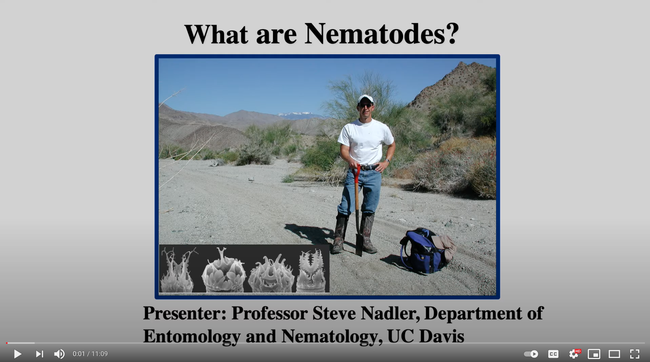
Nematologist Steve Nadler, professor and chair of the UC Davis Department of Entomology and Nematology, presenting a video on nematology. (Screen shot)
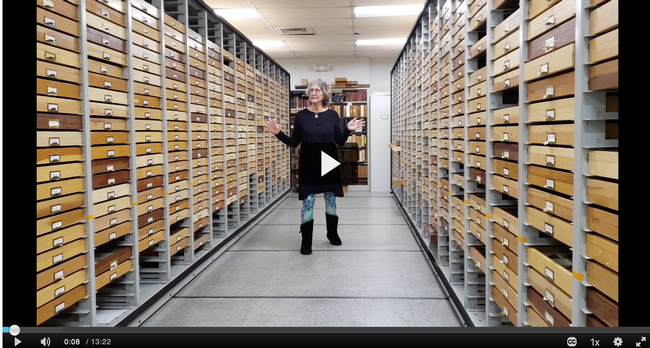
UC Davis entomology professor Diane Ullman offers a virtual tour of the Bohart Museum of Entomology's Lepidoptera collection in this video. (Screen shot)
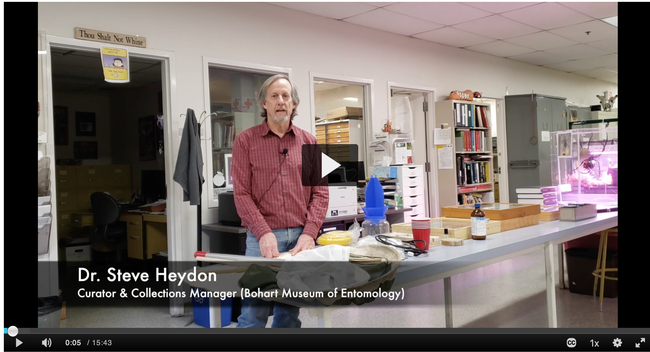
Senior museum scientist Steve Heydon of the Bohart Museum of Entomology, gives an overview of how the museum collects, preserves and identifies some of its nearly 8 million insects. (Screen shot)
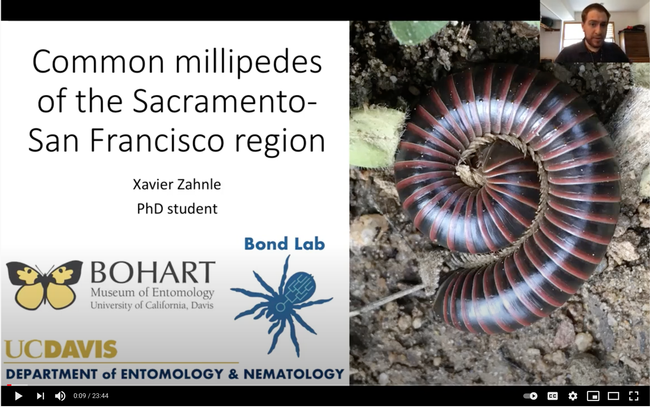
Xavier Zahnle, a doctoral student in the Jason Bond lab, talks about common millipedes in the Sacramento-San Francisco region in this video. (Screen shot)
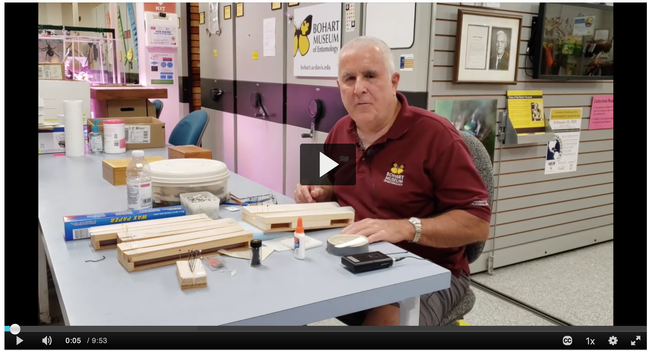
Entomologist Jeff Smith, who curates the Lepidoptera collection, Bohart Museum of Entomology, explains how to pin and spread butterfly and moths for display. (Screen shot)
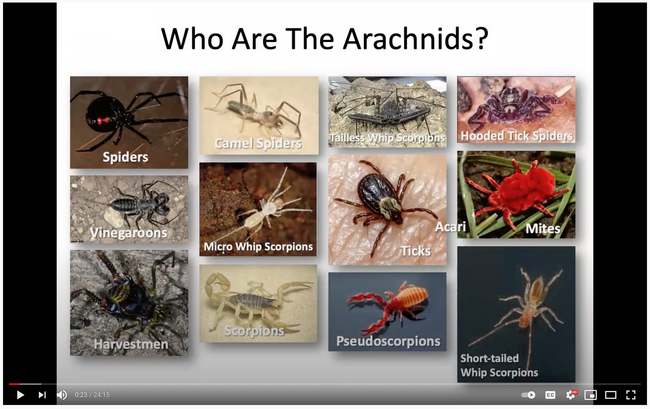
UC Davis doctoral student Lacie Newton of the Jason Bond lab talks about arachnids in her video. (Screen shot)